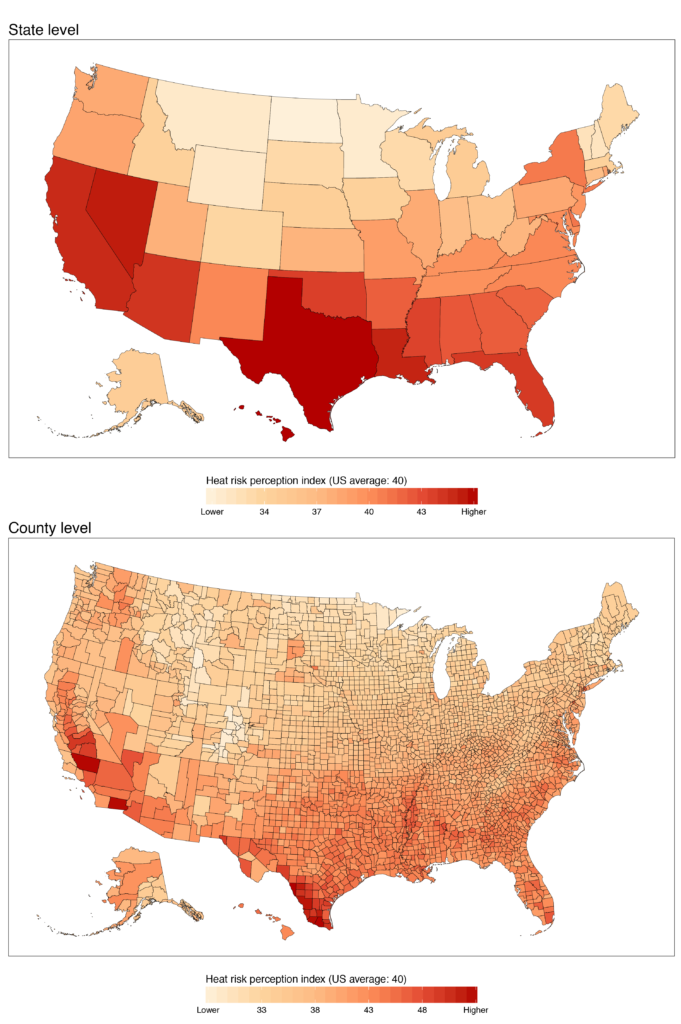Peer-Reviewed Article · Jun 4, 2019
Public perceptions of the health risks of extreme heat across US states, counties, and neighborhoods
By Peter Howe, Jennifer Marlon, Xinran Wang and Anthony Leiserowitz
Filed under: Beliefs & Attitudes

Our article “Public perceptions of the health risks of extreme heat across US states, counties, and neighborhoods” in the Proceedings of the National Academy of Sciences shows how people in different parts of the country perceive the risks of extreme heat and its effects on human health. Accompanying the paper is a new web tool illustrating how public risk perceptions of heat waves vary across state, counties, and even census tracts.
Using a series of surveys during the summer of 2015, coupled with statistical modeling, we mapped heat wave risk perceptions using an index that ranges from 0-100. We found that on average, Americans assign the risk a 40. However, Americans’ risk perceptions vary depending on where they live and, in some cases, how vulnerable they are to heat.
The maps show that people living in warmer climates, such as the southern U.S., perceive more risk than those in cooler climates. However, people living in cooler areas are also at high risk of being harmed from heat waves since they tend to have less access to indoor cooling on days when it is needed. As the climate warms, heat waves are becoming more common and severe across the country, putting more people in danger.
Our high resolution maps reveal the complexity of perceptions within cities. Individuals living in high-income neighborhoods with more white residents have lower risk perceptions than those living in less-affluent areas with more minority residents, who also tend to live in warmer neighborhoods due to the urban heat island effect. In fact, in some places, variations in risk perceptions are as large between neighborhoods in the same city as they are between states with totally different climates.
Understanding the geographic diversity of extreme heat risk perceptions can inform efforts to promote awareness about the causes and consequences of heat waves, which is already the most deadly weather hazard in the U.S. Fatalities from heat exposure can often be avoided when people understand the risks, have the resources to act, and take appropriate action. Avoiding harm can be as simple as increasing fluid intake, using a fan, finding a cooler location, or avoiding overexertion. But if individuals don’t perceive heat exposure as a threat, they are less likely to respond safely.
How worried are people about heat waves?

Note: These figures show the average perceived risk (0-100 scale) of harm to health from extreme heat for each state and county in the U.S. Risk perceptions were measured in terms of likelihood, severity, and worry about the negative health effects from heat waves.
Difference from average perceived risk of harm to health from extreme heat
Note: Values indicate differences from the average risk-perception index for the population of each county (SD = 4.2). Los Angeles County, CA (mean = 47, SD = 4.1); Cook County, IL (mean = 40, SD = 4.5); Harris County, TX (mean = 46, SD = 3.9); and Maricopa County, AZ (mean = 44, SD = 3.8).
The underlying data are downloadable from Utah State University and we encourage you to explore the data for yourself using the online interactive tool.
The individual survey data as well as the model estimates are freely available online, and we hope they are of use to communicators, health officials, academics, and others who are working to promote safe behaviors during heat waves, broader community resilience to heat, and climate change adaptation efforts.
Citation:
Article: Howe, P.D., Marlon, J.R., Wang, X., Leiserowitz, A. (2019). Public perceptions of the health risks of extreme heat across US states, counties, and neighborhoods. Proceedings of the National Academy of Sciences, 116(14), 6743-6748. DOI: https://doi.org/10.1073/pnas.1813145116.
This research was supported by the National Science Foundation Decision, Risk, and Management Sciences Program SES-1459903.
To discuss how the extreme heat risk perception data can help inform your group’s climate communication strategy, please reach out to our partnerships team: ypccc.partners@yale.edu.
